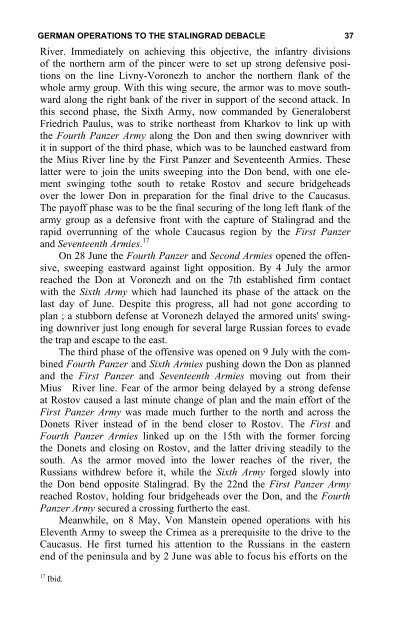the soviet partisan movement 1941-1944 by edgar m. howell
the soviet partisan movement 1941-1944 by edgar m. howell
the soviet partisan movement 1941-1944 by edgar m. howell
You also want an ePaper? Increase the reach of your titles
YUMPU automatically turns print PDFs into web optimized ePapers that Google loves.
GERMAN OPERATIONS TO THE STALINGRAD DEBACLE 37<br />
River. Immediately on achieving this objective, <strong>the</strong> infantry divisions<br />
of <strong>the</strong> nor<strong>the</strong>rn arm of <strong>the</strong> pincer were to set up strong defensive positions<br />
on <strong>the</strong> line Livny-Voronezh to anchor <strong>the</strong> nor<strong>the</strong>rn flank of <strong>the</strong><br />
whole army group. With this wing secure, <strong>the</strong> armor was to move southward<br />
along <strong>the</strong> right bank of <strong>the</strong> river in support of <strong>the</strong> second attack. In<br />
this second phase, <strong>the</strong> Sixth Army, now commanded <strong>by</strong> Generaloberst<br />
Friedrich Paulus, was to strike nor<strong>the</strong>ast from Kharkov to link up with<br />
<strong>the</strong> Fourth Panzer Army along <strong>the</strong> Don and <strong>the</strong>n swing downriver with<br />
it in support of <strong>the</strong> third phase, which was to be launched eastward from<br />
<strong>the</strong> Mius River line <strong>by</strong> <strong>the</strong> First Panzer and Seventeenth Armies. These<br />
latter were to join <strong>the</strong> units sweeping into <strong>the</strong> Don bend, with one element<br />
swinging to<strong>the</strong> south to retake Rostov and secure bridgeheads<br />
over <strong>the</strong> lower Don in preparation for <strong>the</strong> final drive to <strong>the</strong> Caucasus.<br />
The payoff phase was to be <strong>the</strong> final securing of <strong>the</strong> long left flank of <strong>the</strong><br />
army group as a defensive front with <strong>the</strong> capture of Stalingrad and <strong>the</strong><br />
rapid overrunning of <strong>the</strong> whole Caucasus region <strong>by</strong> <strong>the</strong> First Panzer<br />
and Seventeenth Armies. 17<br />
On 28 June <strong>the</strong> Fourth Panzer and Second Armies opened <strong>the</strong> offensive,<br />
sweeping eastward against light opposition. By 4 July <strong>the</strong> armor<br />
reached <strong>the</strong> Don at Voronezh and on <strong>the</strong> 7th established firm contact<br />
with <strong>the</strong> Sixth Army which had launched its phase of <strong>the</strong> attack on <strong>the</strong><br />
last day of June. Despite this progress, all had not gone according to<br />
plan ; a stubborn defense at Voronezh delayed <strong>the</strong> armored units' swinging<br />
downriver just long enough for several large Russian forces to evade<br />
<strong>the</strong> trap and escape to <strong>the</strong> east.<br />
The third phase of <strong>the</strong> offensive was opened on 9 July with <strong>the</strong> combined<br />
Fourth Panzer and Sixth Armies pushing down <strong>the</strong> Don as planned<br />
and <strong>the</strong> First Panzer and Seventeenth Armies moving out from <strong>the</strong>ir<br />
Mius River line. Fear of <strong>the</strong> armor being delayed <strong>by</strong> a strong defense<br />
at Rostov caused a last minute change of plan and <strong>the</strong> main effort of <strong>the</strong><br />
First Panzer Army was made much fur<strong>the</strong>r to <strong>the</strong> north and across <strong>the</strong><br />
Donets River instead of in <strong>the</strong> bend closer to Rostov. The First and<br />
Fourth Panzer Armies linked up on <strong>the</strong> 15th with <strong>the</strong> former forcing<br />
<strong>the</strong> Donets and closing on Rostov, and <strong>the</strong> latter driving steadily to <strong>the</strong><br />
south. As <strong>the</strong> armor moved into <strong>the</strong> lower reaches of <strong>the</strong> river, <strong>the</strong><br />
Russians withdrew before it, while <strong>the</strong> Sixth Army forged slowly into<br />
<strong>the</strong> Don bend opposite Stalingrad. By <strong>the</strong> 22nd <strong>the</strong> First Panzer Army<br />
reached Rostov, holding four bridgeheads over <strong>the</strong> Don, and <strong>the</strong> Fourth<br />
Panzer Army secured a crossing fur<strong>the</strong>rto <strong>the</strong> east.<br />
Meanwhile, on 8 May, Von Manstein opened operations with his<br />
Eleventh Army to sweep <strong>the</strong> Crimea as a prerequisite to <strong>the</strong> drive to <strong>the</strong><br />
Caucasus. He first turned his attention to <strong>the</strong> Russians in <strong>the</strong> eastern<br />
end of <strong>the</strong> peninsula and <strong>by</strong> 2 June was able to focus his efforts on <strong>the</strong><br />
17 Ibid.
















